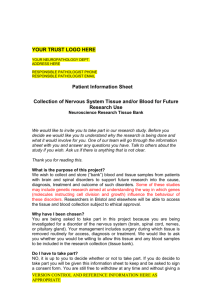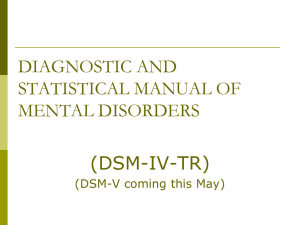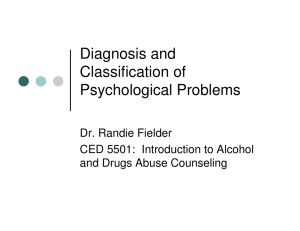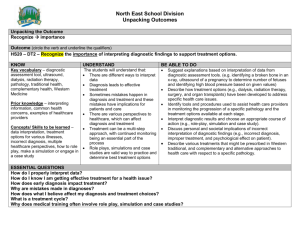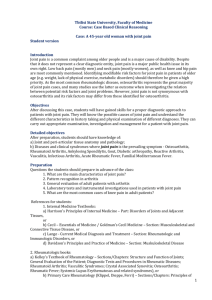Diagnosis and Classification
advertisement
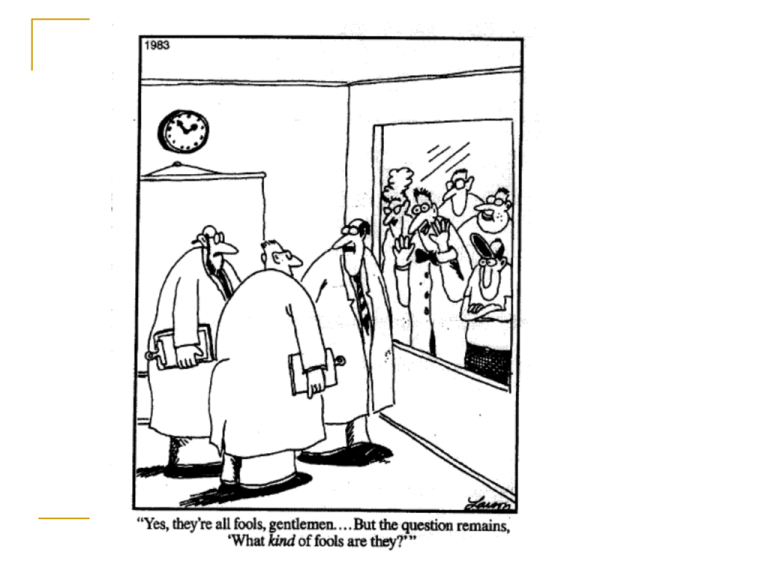
Standards For What Is Normal and Abnormal Cultural relativism Unusualness of behavior Discomfort of the person exhibiting the behavior Mental illness Standard 1: Cultural Relativism No universal standards or rules for labeling a behavior as abnormal. Instead, behaviors can only be abnormal relative to cultural norms. Example: In many cultures, family members sleep together in one room, often in the same bed. In the U.S., it is considered normal for a baby to sleep in her own bed in her own room. Gender Role Expectations How are men expected to act? What types of behaviors are discouraged? How are women encouraged to act? What types of behaviors are discouraged? Standard 2: Unusualness Is the behavior rare? (Depends in part on the norms for that behavior in a culture.) Standard 3: Discomfort Proponents of this view argue that a behavior is only abnormal if the individual suffers as a result of the behavior(s) and wishes to be rid of them. Some therapists object to the subjective discomfort criterion because people are not always aware of problems that their behavior may create for themselves or others. Standard 4: Mental Illness Is the behavior caused by an identifiable disease? There is no medical test that identifies this process if it does exist. Maladaptiveness • • • Does the behavior prevent normal daily functioning? Does the person suffer distress? Is there emotional or physical harm? Definition of “Mental Disorder” DSM-IV-TR: a clinically significant behavioral or psychological syndrome or pattern that occurs in an individual and that is associated with present distress (e.g., a painful symptom) or disability (i.e., impairment in one or more important areas of functioning) or with a significantly increased risk of suffering death, pain, disability, or an important loss of freedom. Definition of “Mental Disorder” In addition, this syndrome or pattern must not be merely an expectable and culturally sanctioned response to a particular event, for example, and death of a loved one. Whatever its original cause, it must currently be considered a manifestation of a behavioral, psychological, or biological dysfunction of the individual. Neither deviant behavior (e.g., political, religious, or sexual) nor conflicts that are primarily between the individual and society are mental disorders unless the deviance or conflict is a symptom of a dysfunction in the individual, as described above. The Purposes of Psychiatric Diagnosis 1. To define clinical entities, so that clinicians have the same understanding of what a diagnostic category means 2. To determine treatment How well a diagnosis defines a disorder and guides treatment depends on it’s validity and reliability Historical Overview of Psychiatric Classification The science of classifying abnormal patterns of behavior and experience is called nosology. The root of nosology can be traced back to Hippocrates, who established a classification scheme that remained influential throughout ancient Greece and Rome Diagnostic categories included mania, melancholia and hysteria DSM-I The first official manual of mental disorders to contain a glossary of descriptions of the diagnostic categories. Used the term “reaction,” reflecting Adolph Meyer’s psychobiological view that mental disorders represented reactions of the personality to psychological, social and biological factors DSM-II ICD-6 (1948) had been the first ICD to include a subdivision on mental disorders, but had only been adopted by 6 countries by 1959. Stengel (1959) found many diagnostic systems in use around the world. This led to the need for a consensual system for all WHO countries, which was to be included in the ICD-8. The resulting system was adopted, with minor revisions, and published as DSM-II in 1968. DSM-II (cont.) Like DSM-I, each disorder represented a categorical entity, with diagnosis based on a brief general description. Ex: Anxiety Neurosis This neurosis is characterized by anxious over-concern extending to panic and frequently associated with somatic symptoms. Unlike phobic neurosis, anxiety may occur under any circumstances and is not restricted to specific situations or objects. This disorder must be distinguished from normal apprehension or fear, which occurs in realistically dangerous situations. DSM-II (cont.) The main problem with DSM-II was the lack of an objective and reliable system for describing psychopathology and determining diagnoses. Technical Advances of the ’70’s Throughout the 1970’s, a number of researchers developed operational criteria for making diagnostic decisions. Feighner, Robins, Guze, et al. (1972) derived explicit diagnostic criteria for 16 diagnostic categories (the “St. Louis Group” at Washington University) – these criteria demonstrated improved reliability, compared with DSM-II diagnoses DSM-III In 1974, the APA appointed the Task Force on Nomenclature and Statistics to begin work on DSM-III Emphasis was placed on increasing reliability and clinical utility Represents a “dramatic departure” from previous DSM’s Innovations of DSM-III 1. 2. 3. 4. 5. 6. 7. Provided a definition of the term “mental disorder” Presented diagnostic criteria for each disorder Introduced the multiaxial diagnostic format Redefined a number of major disorders (e.g., elimination of “neurosis”) Added new diagnostic categories (e.g., personality disorders) Presented a hierarchical organization of diagnostic categories Presented a systematic description of each disorder Innovations of DSM-III 8. 9. 10. 11. Provided decision trees for differential diagnosis Provided a glossary of technical terms Published reliability data from field trials Utilized a descriptive, atheoretical approach DSM-III-R Published in 1987, as a result of on-going research and resulting progress in the understanding of the diagnostic categories. Represented a number of changes, including a revision of the multiaxial system (especially Axis II, which was broadened to include mental retardation, and Axis V, which introduced a more comprehensive rating scale). DSM-IV-TR “Diagnostic and Statistical Manual of Mental Disorders, Fourth Edition, Text Revision” Published by the American Psychiatric Association Primarily used in the United States Includes information only on mental illnesses Classifies mental illnesses into different types of disorders (Mood disorders, psychotic disorders, eating disorders, etc.) Multiaxial Classification Axis I – Clinical Disorders Other Conditions That May Be a Focus of Clinical Attention Axis II – Personality Disorders Mental Retardation Axis III – General Medical Conditions Axis IV – Psychosocial and Environmental Problems Axis V – Global Assessment of Functioning Types of Information in DSM-IV Text Diagnostic Features Subtypes and/or Specifiers Recording Procedures Associated Features and Disorders 1. 2. 3. 4. a) b) c) Associated descriptive features and mental disorders Associated laboratory findings Associated physical examination findings and general medical conditions Types of Information in DSM-IV Text 5. 6. 7. 8. 9. Specific Culture, Age and Gender Features Prevalence Course Familial Pattern Differential Diagnosis Two Diagnostic Approaches Descriptive – diagnoses based on relatively objective phenomena that require little clinical inference (signs, sxs, natural history, etc.) – focus on what 2. Psychological (or dynamic) – diagnoses based primarily on inferred causes and mechanisms, with symptoms frequently being seen as superficial manifestations of a more profound underlying process – focus is on why 1. Two Diagnostic Approaches Both approaches are valuable – each addresses a different aspect of psychopathology Ex: delusions Descriptive – Are they fixed? Vague? Paranoid? Circumscribed? Dynamic – inner mechanism (e.g., projection) that produces the delusion Dimensions of Diagnosis Categorical vs. dimensional Monothetic vs. polythetic Categorical diagnosis – all persons assigned to the same category are alike with respect to some attribute Dimensional – all persons rated on predetermined dimensions Monothetic diagnosis – each category is associated with specific criteria, all of which are considered essential to that category’s definition (also called classical categorization) Effects: 1. comparatively few persons will met the criteria of any one category 2. for those who do, they will show a high degree of behavioral similarity Polythetic (prototypal) diagnosis – each category is associated with a number of criteria, only some of which are necessary for a diagnosis to be assigned. Two advantages over the categorical approach 1. requires fewer categories to classify the great variety of behavioral variation (greater simplicity) 2. more reliable – clinicians do not have to agree on every criterion to arrive at the same diagnosis Disadvantage: individiuals with the same diagnosis may bear little resemblance to each other, in terms of presenting complaints There is a third, mixed approach, in which some criteria are considered necessary for a diagnosis, while other criteria may or may not be met. Ex: Criteria A & B are essential to this diagnosis, while any combination of 2 of the 4 of criteria C, D, E & F will do. Dimensional Approaches to Diagnosis All persons are rated on a pre-determined, quantitatively-based dimensions Ex: Axes IV and V of DSM-IV-TR In dimensional approaches, there is no assumption of behavioral discontinuity – psychopathology is seen as falling on a continuum “more this or less that” not “either/or”
